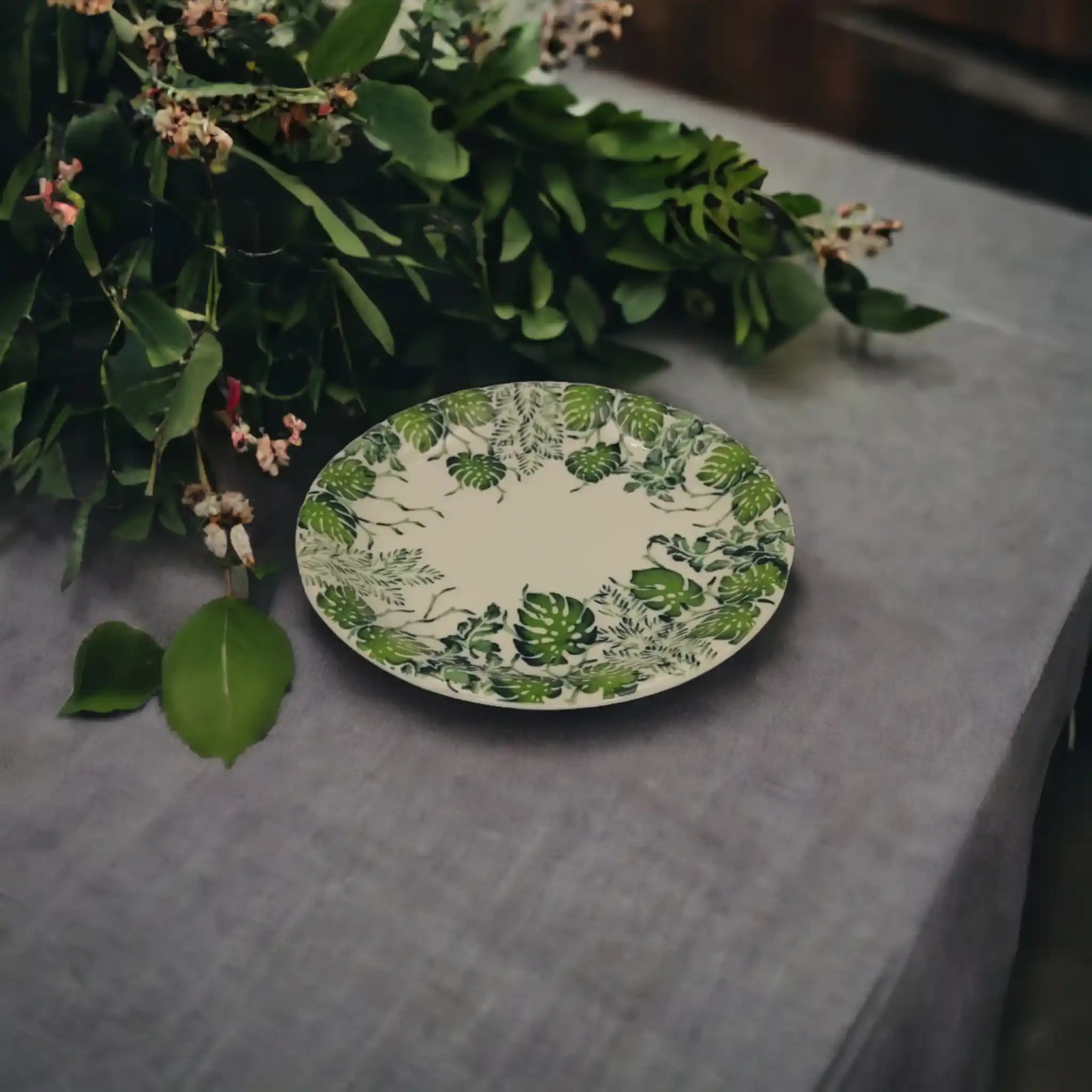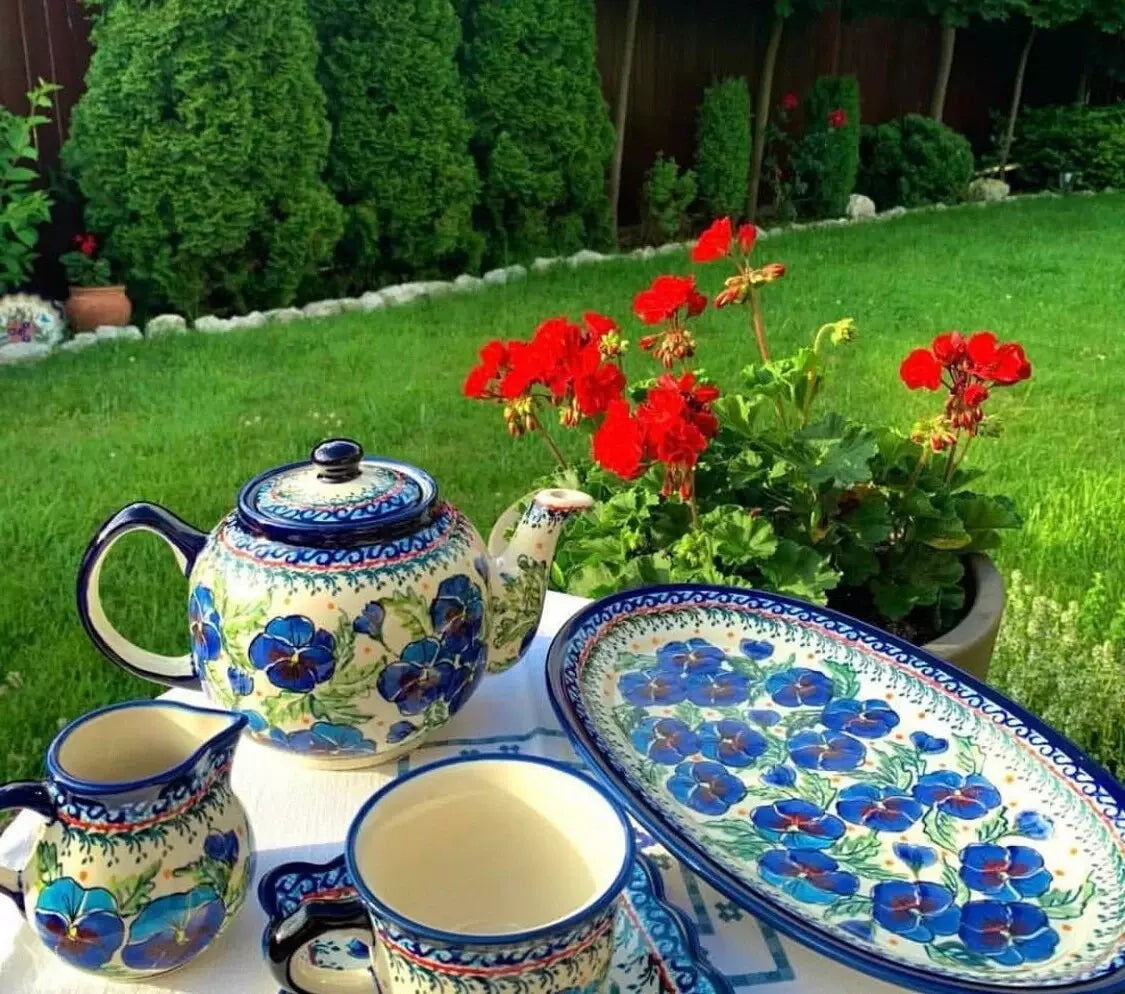




Polish pottery Dessert Plate-Monstera Leaves
This 16-cm Polish pottery Dessert Plate from the Polish Ceramic Works is ideal for eating breakfast, dinner, snacks, or serving guests cake and savory snacks. High-temperature glazing and firing make the decorative motifs highly durable, while the plate is both dishwasher and microwave-safe and can be stored in the refrigerator. Each plate is handcrafted and unique, ideal for completing your tableware set with one decoration or several different ones.
Height (cm) 1.50
Weight (kg) 0.270
Diameter (cm) 16.20
Material Feature: Stoneware
Manufacturer: Zakłady Ceramiczne
Embellishment: Hand-painted Pattern
Specific Uses For Product: Eating and serving food
Special Feature: Dishwasher, microwave, and refrigerator-safe.


Polish pottery is highly famed for its very colorful patterns and outstanding craftsmanship, representing a very rich cultural heritage that dates back as far as the 19th century in Bolesławiec, Poland. This particular form of pottery is often referred to as "Bolesławiec pottery," a name that is virtually recognized in the world due to its durability, intricate design, and unique hand-painted decoration. Production is initiated with locally available clay that is carefully molded into various shapes and forms in the skillful hands of expert artisans. Each of these then is decorated with everything from geometrical to floral motifs, usually in a combination of sponging, stamping, and hand-painting. Probably the most recognizable feature of Polish pottery is the signature blue-and-white color palette, though it also can show up in a rainbow of colors and detailed shapes. It becomes not only beautiful but also chip-resistant and suitable for use every day, for it gets fired in kilns at very high temperatures. Besides being utilitarian, Polish pottery has become highly regarded as a collectible art form with many pieces passing into family heirlooms. It shows pride in the craft and attachment to one's heritage. Moving forward, the art advances with new designs but retains its traditional techniques. Polish pottery enjoys international accolades for its quality and aesthetic appeal, which are equally pleasing, thereby making it a favorite choice the world over, both for practical use and decoration. The continued success and popularity of Polish pottery indeed stand as testimony to the skill and devotion of the artisans who keep this age-old tradition alive by blending history with modern-day elegance in each piece they create.
Polish pottery is highly famed for its very colorful patterns and outstanding craftsmanship, representing a very rich cultural heritage that dates back as far as the 19th century in Bolesławiec, Poland. This particular form of pottery is often referred to as "Bolesławiec pottery," a name that is virtually recognized in the world due to its durability, intricate design, and unique hand-painted decoration. Production is initiated with locally available clay that is carefully molded into various shapes and forms in the skillful hands of expert artisans. Each of these then is decorated with everything from geometrical to floral motifs, usually in a combination of sponging, stamping, and hand-painting. Probably the most recognizable feature of Polish pottery is the signature blue-and-white color palette, though it also can show up in a rainbow of colors and detailed shapes. It becomes not only beautiful but also chip-resistant and suitable for use every day, for it gets fired in kilns at very high temperatures. Besides being utilitarian, Polish pottery has become highly regarded as a collectible art form with many pieces passing into family heirlooms. It shows pride in the craft and attachment to one's heritage. Moving forward, the art advances with new designs but retains its traditional techniques. Polish pottery enjoys international accolades for its quality and aesthetic appeal, which are equally pleasing, thereby making it a favorite choice the world over, both for practical use and decoration. The continued success and popularity of Polish pottery indeed stand as testimony to the skill and devotion of the artisans who keep this age-old tradition alive by blending history with modern-day elegance in each piece they create.


History trails the origin of Polish pottery back to the 19th century in the Bolesławiec town, situated in the southwest part of Poland. In the region, there exist large deposits of good-quality clays, which favored the establishment of the ceramic production center based on raw materials available in that area. Very much entwined in the local community, the origins of Polish pottery dwelled in the need for robust and strong tableware within the local community. The pottery made initially was utilitarian and destined for everyday use. With time, however, the art developed, and the pieces began to possess hand-painted patterns and intricate designs.Bolesławiec pottery, better known as Polish Stoneware or Bolesławiec Stoneware, became liked due to its distinctive style of ornamentation and durability. The early craftsmen used the traditional hand-molding/wheel-throwing techniques and applied advanced methods of glazing in order to give a different look to the pottery. With the invention of sponge painting at the end of the 19th century, craftsmen could do the work of painting such elaborate patterns so much more easily and with far greater accuracy. The traditional blue-and-white color scheme became iconic, though artisans also used other colors and motifs.Throughout the 20th century, Polish pottery continued to evolve from traditional techniques through the many modern influences. Because it was also made in local workshops and cooperatives, the craftsmanship was maintained, along with the tradition and heritage of Bolesławiec pottery. Nowadays, Polish pottery is valued not only for practical purposes but also for its artistic value. It also gained international fame; collectors and enthusiasts from all over the world appreciate its historical importance, together with the art involved in the making of every piece. The rich tradition of Polish pottery lives on, emanating elements of both a historical tradition and modern creativity.
History trails the origin of Polish pottery back to the 19th century in the Bolesławiec town, situated in the southwest part of Poland. In the region, there exist large deposits of good-quality clays, which favored the establishment of the ceramic production center based on raw materials available in that area. Very much entwined in the local community, the origins of Polish pottery dwelled in the need for robust and strong tableware within the local community. The pottery made initially was utilitarian and destined for everyday use. With time, however, the art developed, and the pieces began to possess hand-painted patterns and intricate designs.Bolesławiec pottery, better known as Polish Stoneware or Bolesławiec Stoneware, became liked due to its distinctive style of ornamentation and durability. The early craftsmen used the traditional hand-molding/wheel-throwing techniques and applied advanced methods of glazing in order to give a different look to the pottery. With the invention of sponge painting at the end of the 19th century, craftsmen could do the work of painting such elaborate patterns so much more easily and with far greater accuracy. The traditional blue-and-white color scheme became iconic, though artisans also used other colors and motifs.Throughout the 20th century, Polish pottery continued to evolve from traditional techniques through the many modern influences. Because it was also made in local workshops and cooperatives, the craftsmanship was maintained, along with the tradition and heritage of Bolesławiec pottery. Nowadays, Polish pottery is valued not only for practical purposes but also for its artistic value. It also gained international fame; collectors and enthusiasts from all over the world appreciate its historical importance, together with the art involved in the making of every piece. The rich tradition of Polish pottery lives on, emanating elements of both a historical tradition and modern creativity.

why do you have to purchase Polish pottery?
What is Polish pottery?
Polish pottery is a traditional ceramic ware that is hand-painted and produced in Poland. It is known for its unique designs, vibrant colors, and intricate patterns. Polish pottery is made from high-quality stoneware clay, which gives it durability and makes it suitable for everyday use.
What makes Polish pottery unique?
Polish pottery is known for its high-quality clay and distinctive hand-painted designs. It is also safe for use in the oven, microwave, and dishwasher, making it both functional and attractive.
Why is Polish pottery popular?
The popularity of Polish pottery stems from its exceptional quality, beauty, and versatility. The pottery is handcrafted by skilled artisans using traditional techniques that have been passed down through generations. Its artful designs and vibrant colors make it a great addition to any home decor. Additionally, Polish pottery is dishwasher, microwave, and oven safe, making it highly functional and practical.




